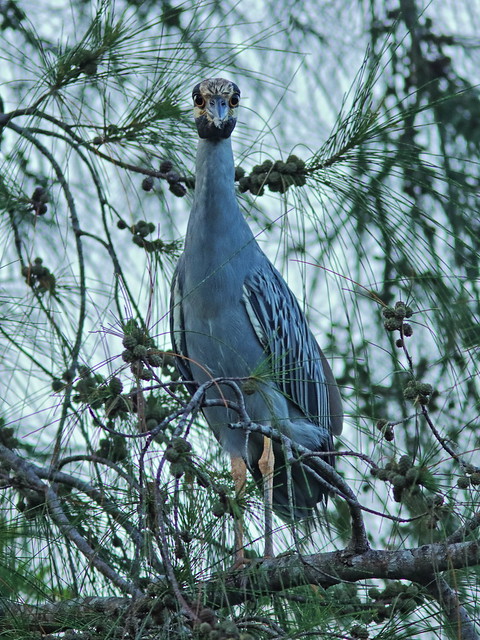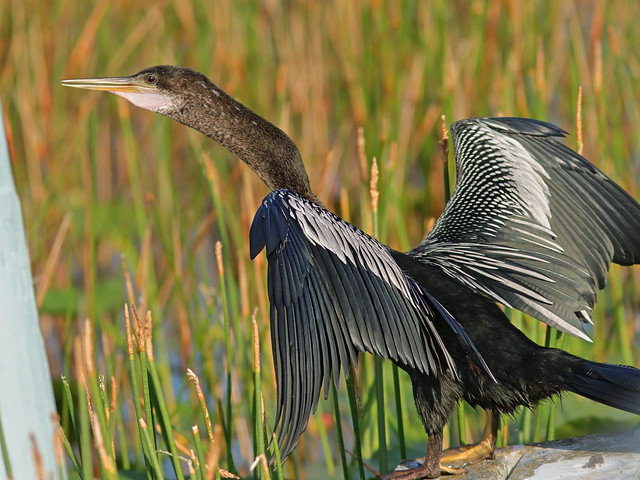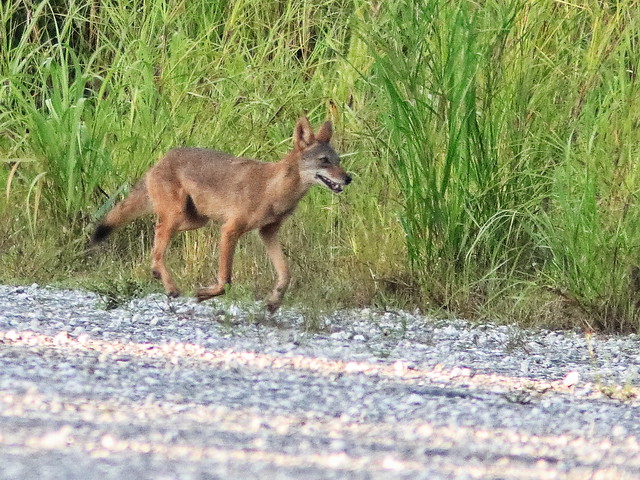It has been another week of clear morning skies and early afternoon downpours, some of which cut short our walks. The bird species list rarely breaks 20, but even the common birds can provide interesting sightings.
An immature Red-shouldered Hawk roosted high on an abandoned telephone pole:
The next morning it selected a cross-timber for preening:
A Great Egret preened lakeside before sunrise, its white plumage contrasting with the reflected pink sky on tranquil waters:
A bit later, the morning rays added contrast and a nice reflection:
A distant Bald Eagle coursed above the lake:
Early morning snaps suffer from underexposure. I could barely see this Yellow-crowned Night-Heron in the dark foliage but was surprised at the clarity of its image:
It turned to look straight at me. During breeding season its cap would have been white with a yellow tinge, but now it is streaked:
At nearby Chapel Trail Nature Preserve, a perky juvenile Northern Cardinal perched on the boardwalk railing:
I am not sure whether it is a male or female. Young birds of both sexes somewhat resemble adult females, but their dark bills contrast with the bright red of their parents:
The post-breeding molt is in progress. This Anhinga revealed its motley tail feathers after it took flight. The central corrugated feather is fresh as compared to the worn ones about to be replaced:
This molting adult Northern Mockingbird's fresh tail feathers are emerging on top of the old worn ones:
This adult male Northern Cardinal also shows loss of feathers on his head, exposing his black facial skin:
To be kind to the birds when they are not in their best attire, I often back off to show their habitat. This male is harvesting the berries of a Trema tree:
Another juvenile cardinal chews on a the Trema fruit:
I was surprised to find a warbler, an American Redstart, also plucking the berries:
Redstarts are not commonly encountered here during midsummer, as they normally breed north of Florida. This one appears to be an adult female. It was the only one seen in our our County, of the three reported in all of south Florida during this month:
This week's biggest surprise was a Coyote crossing the gravel road in front of me. It was quite far away and the early morning light was not very intense, so my photos are soft:
I found a small patch of wild Poinsettia. The cultivated "Christmas Flowers" have an array of entirely red petal-like leaves (bracts) which surround the tiny yellow flowers:
Lingering Saharan dust continues to provide color at sunrise. The rising sun issues crepuscular solar rays...
...which converge as anti-crepuscular (anti-solar) rays over the Everglades to the west:
= = = = = = = = = = = = = = =
Linking to:
Fences Around the World
Skywatch Friday
Weekend Reflections
Saturday's Critters
BirdD'Pot
Camera Critters
All Seasons
Wordless Wednesday (on Tuesday)
Natasha Musing
Our World Tuesday
Please visit the links to all these posts to see some excellent photos on display
________________________________________________

























Wonderful pictures as always..Hawks are among my favorites..The Coyote looks much like our foxes..only taller..I didn't realize that they had black tipped tails as well..Our Cardinals look pretty much like yours right now. The first 2 Heron pics look like chalk or watercolor paintings..so soft..
ReplyDeleteGreat Night Heron image!!
I am always in awe with your knowledge of wild life. nice shots.
ReplyDeleteEnjoyed viewing this. Many beautiful photos as always.
ReplyDeleteFun shots of the coyote. It appears to be having a good time. Love the heron close-up photos!
ReplyDeleteGreat photos! Have a good weekend.
ReplyDeleteHello, Ken
ReplyDeleteI just love your views of the skies, beautiful captures. The Yellow-crowned Night Heron, Anhinga and Cardinal images are my favorite. Wonderful sightings of the Hawk, Egret and the Coyote. Thank you for linking up and sharing your post. Take care, have a happy weekend! PS, thank you for the comment on my blog.
Nice post! I especially like the yellow-crowned night-Heron photos. The other evening a coyote ran in my direction but thankfully turned a few yards away.
ReplyDeleteThese are wonderful sightings and photographs. I would like to see the Yellow-crowned Night-Heron in its breeding appearance.
ReplyDeleteLove the surprise coyote!!
ReplyDeleteAnd my favorite today? "Take me to your leader". Thanks so much for taking time to share your birds and nature with us at IRBB this weekend.
The close up of the night heron is fantastic!! #Allseasons
ReplyDeleteThe lovely North cardinal is one such bird that I have never seen in my region. The poinsettia seems to be in the good flowering state. Thanks for sharing with Garden Affair
ReplyDeleteI really enjoyed your "potpourri", Ken! Splendid photographs.
ReplyDeleteThe daily thunderstorms may crimp our style a bit, but I'm glad for the rain and the fact they pretty much have a "schedule" so we can arrange our outdoor calendar's accordingly. Sometimes .....
The molting season explains why so much of our birding territory is somewhat quiet. Birds are vulnerable with a limited ability to fly until the new feathers are in place.
Take care, Ken, and don't overdo it in our delightful humidity!
I always feel sorry for molting birds, especially cardinals. I wonder if they are as vain as we humans would be to see their "outfits" go shabby?
ReplyDeleteThanks for sharing your lovely photos at https://image-in-ing.blogspot.com/2021/08/american-tobacco-campus-durham-nc.html
The shots of the Anhinga, even with the motley tail feathers, was my favorite in this series, Ken. I always enjoy seeing egrets of any type as these large shorebirds always look so graceful. The birds may not be at their best when molting, but the same could be said of some humans.
ReplyDeleteIncredible photos!
ReplyDelete